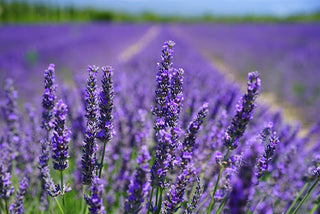The flowering plant is an essential ingredient in making wellness functional tea, which is why it is a must-have for households with tea lovers. The many uses and advantages of lavender have been known for millennia.
Lavender's benefits span from mental and physical relaxation to glowing skin and shiny hair. This article will explore how you may be able to incorporate lavender into your lifestyle and the facts you need to know about this amazing plant.
What is Lavender?
Lavender is a perennial herb of the mint family, native to the Mediterranean region. However, it is currently cultivated worldwide for its medicinal and culinary uses.
The most common lavender species is Lavandula angustifolia (English lavender). Other species include Lavandula intermedia (Dutch lavender), Lavandula stoechas (French lavender), and Lavandula latifolia (Spike lavender).
Interesting Facts about Lavender
- The flowers and leaves of the lavender plant are used to make essential oils for perfumes, soaps, and other personal care products.
- Lavender is a natural stress reliever. Its calming scent has the potential to reduce symptoms of insomnia. It has traditionally been used in aromatherapy, and can also be added to bathwater, drunk as a wellness functional tea, or applied topically to the skin.
- Traditional and Folk healers use Lavender to treat various ailments, including anxiety, insomnia, and headaches.
- The dried flowers of the lavender plant can be used in potpourri, wellness functional tea, and other crafts.
- Lavender is a natural insect repellent. Its strong scent deters bugs and insects, making it a great natural alternative to chemical-based bug sprays.
- Lavender is a natural deodorizer. Its strong scent helps to remove odors.
- Lavender oil is also popular in many skin care products due to its antiseptic and anti-inflammatory properties. In some instances, it can help soothe mild cases of sunburn, eczema, and other skin conditions.
- Lavender is also used in cooking and baking. Its floral flavor is perfect for sweet and savory dishes and can be used to make wellness functional tea, syrups, and even ice cream.
- Lavender is a hardy and easy-to-grow plant. It is drought-tolerant and prefers well-drained soil in a sunny location.
- The color of lavender flowers can range from white to pale pink to deep purple. The most common color is soft purple, which is why it is often associated with purple.
- Dried lavender flowers and sachets of lavender are often used to scent linens and clothing and to deter moths and other insects.
- Lavender is not just for humans; it can also be used for pets. It can help reduce stress and anxiety in dogs, cats, and other animals and at times is also used to help with animal skin conditions.
- The essential oil of lavender is obtained by steam distillation of the flowers.
- Lavender symbolizes innocence, purity, devotion, and relaxation. It is a popular choice in bridal bouquets and other love-themed flower arrangements.
- Even the British monarch, Queen Victoria, enjoyed the calming effects of lavender. Supposedly, she drank lavender tea for headaches and stomach relief. In addition, she asked that her bedding be scented with lavender.
- Ancient Egyptians used lavender for embalming bodies during mummification.
4 Ways to Use Lavender
1. Ease Stress
Lavender is a natural anti-stress remedy. Its soothing aroma is thought to have a sedative effect on the nervous system. Research suggests that the scent of lavender can lower blood pressure and heart rate. It may also be a welcome relief for those who suffer from sleeplessness.
Additionally, using lavender in a massage or a bath may help reduce muscle tension and promote well-being. It can be used in various forms, such as essential oil, aromatherapy, dried flowers, and even wellness functional tea.
2. Cooking
Lavender is a wonderful flavor for desserts and baked goods, such as cakes, cookies, and bread. It can also flavor savory dishes like marinades, dressings, and sauces. However, it has a strong flavor, so a little goes a long way. Additionally, varieties of lavender may contain pesticides or other chemicals that are not healthy for human consumption; therefore, it is essential to use lavender grown explicitly for culinary purposes.
3. Beauty Products
Lavender is often used in soaps, lotions, creams, shampoos, and conditioners. It has anti-inflammatory and anti-bacterial properties, making it a popular ingredient in sensitive and acne-prone skin products. Aromatherapists use lavender oil to promote relaxation and reduce stress.
4. Tea
Lavender-infused wellness functional tea has supportive healing properties for your physical and emotional well-being. The relaxing and soothing effects of lavender make it an excellent addition to tea. So, after a long day, grab a cup of wellness functional tea to relax.
The unique combination of herbal infusion and wellness function in lavender tea underscores the interconnectedness of physical and emotional health. “Harnessing the power of lavender in this aromatic tea not only pleases your palate, but also nurtures your mind and body,” notes Heidi Wright, Registered Nurse and Certified Herbalist.
Incorporating lavender-infused wellness functional tea into your routine can be a simple yet effective way to prioritize self-care. As you sip the fragrant brew, allow the calming properties of lavender to envelop you, creating a space for relaxation and rejuvenation. Whether as a morning ritual or an evening wind-down, this tea offers a gentle reminder of the potential for healing that lies within the natural treasures our world provides.

